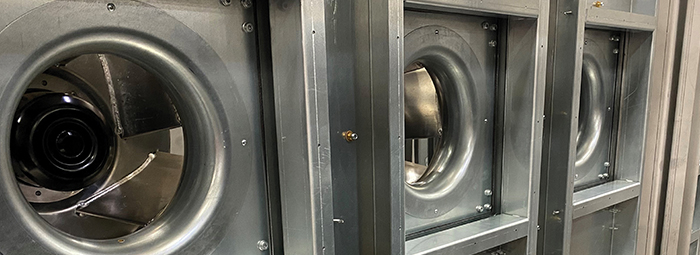
© 2021 This excerpt taken from the article of the same name which appeared in ASHRAE Journal, vol. 63, no. 12, December 2021.
About the Authors
B. Rajavel is an acoustic engineer, Tom Bise is an airflow engineer and Paul Bauch is an acoustic engineer with Johnson Controls Inc., in the air-handling systems, applied equipment division in York, Pa.
At the heart of every air-handling system is a fan or set of fans that move air and overcome system losses. When coupled with motors, which turn electrical power into mechanical power, fans convert that mechanical power into air power. In modern, high-performance systems, motor controllers are often used to provide speed control. Each of these components—fan, motor and controller—have inherent losses or inefficiencies. These losses can be measured in a laboratory to evaluate the net effect on the system’s wire-to-air efficiency, which describes the total electrical energy needed to produce the required airflow and pressure. The study discussed in this article compares four different fan-motor-controller systems as part of a strategy for improving wire-to-air efficiency.
The four fan systems include: (1) an airfoil impeller driven by an induction motor with a VFD controller; (2) the same impeller driven by an electronically commutated (EC) motor with an integral controller; (3) a second EC motor-integral controller with backward-curved impeller; and (4) the second EC motor-integral controller with airfoil impeller. In this work only direct-drive fan systems were considered, though the findings could be extended to belt-drive fan systems.
From the study, it is concluded that impeller design is a leading factor for wire-to-air efficiency, with the motor-controller combination having a smaller, secondary effect if the fan system operates in full-load (design) conditions. However, if the fan system operates at off-load conditions, then impeller, motor and controller are all similarly contributing factors to wire-to-air efficiency.
Air-handling units (AHUs) are an integral part of almost all residential, commercial and industrial HVAC systems. Air-handling systems are generally used to achieve two important goals: provide thermal comfort and achieve acceptable indoor air quality (IAQ). They meet these objectives by using their electrically powered fan system to move conditioned air through the occupied space.
Electric motors that power fan systems have been identified as the one of the biggest energy consumers in buildings. Fans used in HVAC systems are among the largest consumers of electrical power, consuming more than 22% of the all the electricity used in the European Union. It is estimated that 18% of electricity consumed by motors is consumed in fan applications. In the U.S., commercial buildings account for 35% of electricity consumption, and HVAC&R applications account for nearly 46% of the total electricity consumed by buildings. Thus, reducing fan power consumption can have a significant impact on building energy use.
The fan system efficiency, i.e., the ability to convert electrical power to air power, is a function of the fan’s aerodynamics and the motor, transmission and controller efficiencies, with the primary factor being the aerodynamic efficiency of the fan. Though the fan system consists of other components such as motors (AC induction or electronically commutated [EC]), variable speed drives (VSD), and transmission components (belts, pulleys and bearings) to transmit the power from the motor to the fan impeller, the efficiency losses in these devices are significantly less than the aerodynamic losses of the fan impeller in full-load conditions. However, in part-load conditions (for example, less than 50% of maximum load) these efficiencies can be more similar.
Read the Full Article
ASHRAE Members have free access to the full-text PDF of this article as well as the complete ASHRAE Journal archives back to 1997 in the Free Member Access Area.
Non-members can purchase features from the ASHRAE Bookstore. Or, Join ASHRAE!
Return to Featured Article Excerpts
Return to ASHRAE Journal Featured Article Excerpts